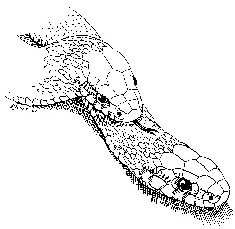

Michael P.
LeMaster | Western Oregon University | Department
of Biology | 345 N. Monmouth Ave. | Monmouth, OR 97361
Plains Garter Snake
illustration by Rick Jones, ©2000
| PUBLICATIONS |
| Edited Books: | |
Mason,
R.T., LeMaster, M.P., and Muller-Schwarze, D. (eds.). 2005. Chemical
Signals in Vertebrates 10. 432 pgs. Springer, New York, New York. |
|
| Refereed Chapters in Books: | |
LeMaster,
M.P., Stefani, A., Shine, R., and Mason, R.T. 2007.
Cross-dressing in Chemical Cues: Exploring she-maleness in newly-emerged
male garter
snakes. In: Chemical Signals in Vertebrates 11 (eds. J.L. Hurst,
R.J. Beynon, S.C. Roberts, and T.D. Wyatt). Springer, 223-230. |
|
LeMaster,
M.P. and Mason, R.T. 2001. Annual and seasonal variation
in the female sexual attractiveness
pheromone of the red-sided
garter snake, Thamnophis sirtalis parietalis. In: Chemical Signals
in Vertebrates 9 (eds. A. Marchlewska-Koj, J. Lepri, and D. Müller-Schwarze).
Plenum Press, 369-374. |
|
Torgersen,
C.E., Jones J.A., Moldenke, A.R., and LeMaster,
M.P. 1995.
The spatial heterogeneity of soil invertebrates and edaphic properties
in an old growth forest stand in western Oregon. In: The Significance
and Regulation of Soil Biodiversity (eds. H.P. Collins, G.P.
Robertson, and M.J. Klug). Kluwer Academic Publishers, 225-236. |
|
| Peer-reviewed Journal Articles: | |
Lutterschmidt, D.I., LeMaster,
M.P., and Mason, R.T. 2006. Minimal
over-wintering temperatures of red-sided garter snakes (Thamnophis
sirtalis parietalis): A possible cue for emergence? Canadian
Journal of Zoology 84:771-777. |
|
Lutterschmidt, D.I, LeMaster,
M.P., and Mason R.T. 2004. Effects
of melatonin on the behavioral and hormonal responses of red-sided
garter snakes (Thamnophis sirtalis parietalis) to exogenous corticosterone.
Hormones and Behavior 46:692-702. |
|
Shine, R., LeMaster,
M., Wall, M., Langkilde, T., and Mason, R.T.
2004. Why did the snake cross the road? Effects of roads on movement
and mate-location by garter snakes (Thamnophis sirtalis parietalis).
Ecology and Society 9:9. |
|
Shine, R., Phillips, B., Waye, H., LeMaster,
M., and Mason, R.T.
2004. Species isolating mechanisms in a mating system with male mate
choice (garter snakes, Thamnophis). Canadian Journal of Zoology 82:1091-1098. |
|
Shine, R., Phillips, B., Waye, H., LeMaster,
M., and Mason, R.T.
2003. Chemosensory cues allow courting male garter snakes to assess
body length and body condition of potential mates. Behavioral
Ecology and Sociobiology 54:162-166. |
|
LeMaster,
M.P. and Mason, R.T. 2003. Pheromonally-mediated sexual
isolation between denning populations of red-sided garter snakes, Thamnophis
sirtalis parietalis. Journal of Chemical Ecology 29:1027-1043. |
|
Shine, R., Phillip, B., Waye, H., LeMaster,
M., and Mason, R.T. 2003.
The lexicon of love: what cues cause size-assortative courtship by
male garter snakes? Behavioral Ecology and Sociobiology 53:234-237. |
|
Shine, R., Reed, R.N., Shetty, S., LeMaster,
M., and Mason, R.T.
2002. Reproductive isolating mechanisms between two sympatric sibling
species of sea snakes. Evolution 56:1655-1662. |
|
LeMaster,
M.P. and Mason, R.T. 2002. Variation in a sexual attractiveness
pheromone controls male mate choice garter snakes. Journal of
Chemical Ecology 28:1269-1285. |
|
Shine, R., Phillips, B., Waye, H., LeMaster,
M.P., and Mason, R.T.
2001. Advantage of female mimicry in snakes. Nature 414:267. |
|
LeMaster,
M.P., Moore, I.T., and Mason, R.T. 2001. Conspecific trailing
behavior of red-sided garter snakes (Thamnophis sirtalis parietalis)
in the natural environment. Animal Behaviour 61:827-833. |
|
LeMaster,
M.P. and Mason R.T. 2001. Evidence for a female sex pheromone
mediating male trailing behavior in the red-sided garter snake, Thamnophis
sirtalis parietalis. Chemoecology 11:149-152. |
|
Shine, R., O’Connor, D.,
LeMaster, M.P., and Mason, R.T. 2001. Pick on someone your own
size: Ontogenetic
shifts in mate choice by
male garter snakes result in size-assortative mating. Animal
Behaviour 61:1133-1141. |
|
Shine, R., Elphick, M.J., Harlow, P.S., Moore, I.T., LeMaster,
M.P.,
and Mason, R.T. 2001. Movements, mating and dispersal of red-sided
garter snakes from a communal den in Manitoba. Copeia 2001:82-91. |
|
Shine, R., LeMaster,
M.P., Moore, I.T., Olsson, M.M., and Mason,
R.T. 2001. Bumpus in the snake den: Effects of sex, size and body condition
on mortality of red-sided garter snakes. Evolution 55:598-604. |
|
Shine R, Olsson M.M., LeMaster
M.P., Moore I.T, and Mason R.T. 2000.
Are snakes right-handed? Asymmetry in hemipenis size and usage in garter
snakes (Thamnophis sirtalis). Behavioral Ecology 11(4):411-415. |
|
Shine, R., Olsson, M.M., LeMaster,
M.P., Moore, I.T., and Mason,
R.T. 2000. Effects of sex, body size, temperature, and location on
the antipredator tactics of free-ranging garter snakes (Thamnophis
sirtalis, Colubridae). Behavioral Ecology 11(3):239-245. |
|
Moore,
I.T., LeMaster,
M.P., and Mason, R.T. 2000. Behavioral and
hormonal responses to capture stress in the male red-sided garter
snake,
Thamnophis sirtalis parietalis. Animal Behaviour 59:529-534. |
|
Shine,
R., Olsson, M.M., Moore, I.T., LeMaster,
M.P., Greene, M.,
and Mason, R.T. 2000. Body size enhances mating success in male garter
snakes. Animal Behaviour 59:F4-F11. |
|
Shine, R., Olsson, M.M., Harlow, P., LeMaster,
M.P., Moore, I.T.,
and Mason, R.T. 2000. The transvestite serpent: Why do some male garter
snakes court (some) other males? Animal Behaviour 59:349-359. |
|
Shine, R., Olsson, M.M., Moore, I.T., LeMaster,
M.P., and Mason, R.T.
1999. Why do male snakes have longer tails than females? Proceedings
of the Royal Society Series B 266:2147-2151. |
|